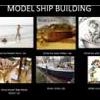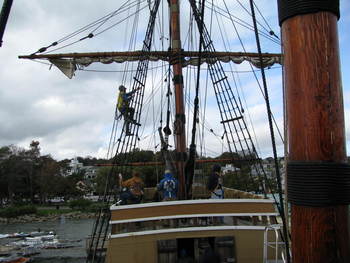-
Posts
728 -
Joined
-
Last visited
Content Type
Profiles
Forums
Gallery
Events
Everything posted by capnharv2
-

Turning cannon's
capnharv2 replied to garyshipwright's topic in Metal Work, Soldering and Metal Fittings
Thanks Mark. I've looked at this site before (it's quite good), and plan to use the grinding guidelines and sequence shown. But somewhere I read that bits for turning ship model parts were a little different than the guidelines shown in the .pdf. I read that the nose is a tighter radius, but I couldn't find what the other differences were. That's why some pictures of bits for turning model cannon would help me. Thanks again, Harvey -
I'm with Keith. The walnut looks great. A little shine and she'll be stunning! Harvey
- 89 replies
-
- muscongus bay lobster smack
- midwest products
-
(and 1 more)
Tagged with:
-

Turning cannon's
capnharv2 replied to garyshipwright's topic in Metal Work, Soldering and Metal Fittings
Gary, I read in NRJ about somebody (probably here on MSW) who made a duplicator to turn cannon from Ebony. He was able to produce them a lot faster (and more consistently) than brass. Of course, Ebony does have its downsides. I also recall something from Rev Romero about turning cannon in boxwood and painting them. I think it was in his Confederacy practicum. I haven't turned any cannon before, so I'd like to see some pictures of the tools used, as well as the process. Thanks, Harvey -
I must be sick since I've always clove hitched my ratlines
- 732 replies
-
- constitution
- model shipways
-
(and 1 more)
Tagged with:
-

Turning cannon's
capnharv2 replied to garyshipwright's topic in Metal Work, Soldering and Metal Fittings
Mark, Would you post a picture of your cutters? I kind of understand, but a couple photos would help. Thanks, Harvey -
Keith, Standing rigging is black because it's coated in tar as a preservative. It's normally adjusted very little (in day to day operations of the ship). Running rigging, on the other hand, was moving with every change of sail movement (up, down, reef, tacking, etc). So it needed to be flexible. Have you heard the phrase "Worm and parcel with the lay, seize and serve the other way"? Worming (running small line in the lay of the line) and parcelling (covering the wormed standing rigging with tarred cloth-I believe canvas) were added to help preserve the standing rigging. Serving (wrapping small line tightly around the standing rigging) was also done for chafe protection. With our use of synthetic line and sailcloth, we often forget that these same items wore out a lot on older vessels. Hemp rigging, even with all that treatment, did rot. Sails (either flax or cotton or whatever else was used) also rotted, and the rigging and sails were constantly being repaired and maintained. That's why most ship that travelled any distance had a rigger and a sailmaker (and a carpenter to fix broken and rotted wood). I couldn't even fathom a guess what the top hamper weighed. But you're correct that wet rigging was a lot heavier than dry rigging (ans still is). Gil, thanks again for showing us your fine work. I hope we (PSSM) will have a chance to see your Victory in person when finished. Harvey
- 755 replies
-
- finished
- caldercraft
-
(and 1 more)
Tagged with:
-
Keith, Everything was fine for me till I got to organic chemistry. Harvey
- 755 replies
-
- finished
- caldercraft
-
(and 1 more)
Tagged with:
-
- 160 replies
-
- harriet lane
- model shipways
-
(and 1 more)
Tagged with:
-
Hi Sarah, Good start on the ratlines! Remember not to get them too tight. I find, on your spacing template, that tracing the shrouds will help you from pulling them together too much (I believe Brian Toss calls that "Siameseing"). Another thing to consider (I believe they started doing it around the time of the HL) is to make every fourth ratline from wood. That will help maintain shroud spacing and reduce the monotony of all those clove hitches. I'll check around. I know the schooner Wawona had every 4th ratline made of wood. If I can find a picture I'll post it here. Thanks, Harvey
- 160 replies
-
- harriet lane
- model shipways
-
(and 1 more)
Tagged with:
-

Full-scale Ringbolt Installation
capnharv2 replied to RiverRat's topic in Masting, rigging and sails
Try all of the above. If the ring bolt (or any deck fitting for that matter) is going to take loads other than shear (parallel to the deck loads), it's probably thru bolted with large washers and backing blocks. If the load is high, they will probably secure it thru a deck beam or sheer clamp. If it's lightly loaded it can be held in place with wood screws. Some production boat manufacturers will get by as cheap as they can-you can see this with small deck cleats screwed into the deck-with little concern for the load it will have to take. Anyway, that's what I've seen. YMMV. Hope the helps. Thanks, Harvey I had another thought. When I first started building ship models, I thought nothing of gluing anything and everything to the deck (bulwarks, etc). It wasn't till I tried using these parts (like a belaying pin rack) that they came loose under load. That's when I realized that we need to provide some positive attachment of our fitting to our models, similar to the real thing. -
Jeff, That's why Bob went to plastic instead of wood-to get away from the grain effects. But the parts are so small and fragile that even styrene had its issues. Jay's solution is much simpler, cleaner and less labor intensive. Thanks, Harvey
- 732 replies
-
- constitution
- model shipways
-
(and 1 more)
Tagged with:
-
That's a great method Jay! It's much cleaner than anything I could cut, sand or scrape. In some ways, I wish I hadn't seen this. Re-doing the scroll work was one of the reasons I didn't want to rebuild my head rails for the 5th time . Now I have one less excuse to avoid it Thanks again, Harvey
- 732 replies
-
- constitution
- model shipways
-
(and 1 more)
Tagged with:
-
Tom, First off, I apologize for not responding sooner. I hope I'm not too late. . . I just checked-I believe I used a #70 bit. I found that the small drill bit sets and a pin vise are slow and not always accurate enough (for me). I drilled these in a Dremel drill press with a 1/8" shank #70 bit. And yes, it goes thru the rim and hub, but only the spoke side of the hub. Otherwise, I'd have 20 holes in the hub and no hub left (literally). Regarding the spoke alignment being out of plane, I did draw a circle in plane for the holes. When I drilled the holes though, I didn't put pilot holes in and the drilled holes themselves are out of plane. Something to remember next time. Thanks for your questions. I'll try to be more responsive next time. Harvey
-
Bob, I have that strip cutter too. It works fairly well if all you cut is soft thin balsa Thanks, Harvey
-
So, let's see. The canoe is 1:12, the HL is 1:144. Does that mean that the HL is 1:12 scale for the people in the canoe? Harvey
- 45 replies
-
- peterboro canoe
- Midwest Products
-
(and 1 more)
Tagged with:
-
What is this? Pink Elephants on parade?
- 89 replies
-
- muscongus bay lobster smack
- midwest products
-
(and 1 more)
Tagged with:
-
The Emma Berry was a Noank smack, built for fishing in Long Island Sound. These types of work boats have a lot of similarities, but they have distinct features for the area the were designed for-and that area was not always a very large area. If you look at the Emma Berry vs. The Estella A (a Friendship Sloop also at Mystic) vs. the Hudson River Sloop Clearwater, they all have similar features, but are different for the waters they were designed for. Hope that doesn't muddy the waters too much Harvey
- 89 replies
-
- muscongus bay lobster smack
- midwest products
-
(and 1 more)
Tagged with:
-
Looks Excellent Jay! It's nice when it all starts to come together, Harvey
- 732 replies
-
- constitution
- model shipways
-
(and 1 more)
Tagged with:
-
Dee Dee, It's looking really good! Regarding Ranger, I understand that the Muscongus Bay Lobster Smacks went thru some evolution until they finally morphed into the Friendship Sloop. I believe that Ranger was one of the earlier versions, and the Chapelle model was a later version. Unstayed masts are not unusual on boats of this era and size. They're designed to bend and spill wind when overpowered. It's alarming, at first, to watch the mast bend 5 feet or so at the top. After a while you begin to understand the the unstayed bendy mast is a safety valve when in gusty conditions. I find it a little sad that, as opposed to Friendship Sloops, Muscongus Bay Lobster Smacks are poorly documented (in general). I don't know if the Penobscot Maritime Museum has a much information, but it's certainly a boat that deserves more visibility. Thanks, Harvey
- 89 replies
-
- muscongus bay lobster smack
- midwest products
-
(and 1 more)
Tagged with:
-

Cool tool lathe Unimat (moved by admin)
capnharv2 replied to Sjors's topic in Modeling tools and Workshop Equipment
Ian, I think a thread on how you improve your small lathe would be really helpful. One problem I have with most of the U3 "improvement" books is that many of the accessories and improvements either require a larger lathe/mill, or a precision with hand tools (hacksaws and files) that I may never achieve. But then, that's one reason why I enjoy working with wood more than working with metal. Thanks, Harvey
About us
Modelshipworld - Advancing Ship Modeling through Research
SSL Secured
Your security is important for us so this Website is SSL-Secured
NRG Mailing Address
Nautical Research Guild
237 South Lincoln Street
Westmont IL, 60559-1917
Model Ship World ® and the MSW logo are Registered Trademarks, and belong to the Nautical Research Guild (United States Patent and Trademark Office: No. 6,929,264 & No. 6,929,274, registered Dec. 20, 2022)
Helpful Links
About the NRG
If you enjoy building ship models that are historically accurate as well as beautiful, then The Nautical Research Guild (NRG) is just right for you.
The Guild is a non-profit educational organization whose mission is to “Advance Ship Modeling Through Research”. We provide support to our members in their efforts to raise the quality of their model ships.
The Nautical Research Guild has published our world-renowned quarterly magazine, The Nautical Research Journal, since 1955. The pages of the Journal are full of articles by accomplished ship modelers who show you how they create those exquisite details on their models, and by maritime historians who show you the correct details to build. The Journal is available in both print and digital editions. Go to the NRG web site (www.thenrg.org) to download a complimentary digital copy of the Journal. The NRG also publishes plan sets, books and compilations of back issues of the Journal and the former Ships in Scale and Model Ship Builder magazines.



